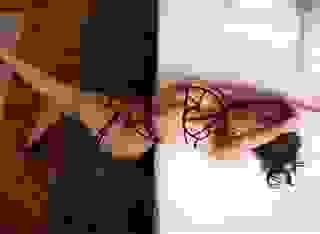- Reviews & Essays
- Body Art: Piercing
Note: You can change font size, font face, and turn on dark mode by clicking the "A" icon tab in the Story Info Box.
You can temporarily switch back to a Classic Literotica® experience during our ongoing public Beta testing. Please consider leaving feedback on issues you experience or suggest improvements.
Click hereBody Art: Piercing
Another form of body modification is piercing. Piercing has also been around since the dawn of time.
Nose piercing was first recorded approximately 4,000 years ago. The Bible in Genesis 24:22 Abraham requested his oldest servant to find a wife for his son Isaac, the servant found Rebekah, and one of the gifts he gave her was a "golden earring" the original Hebrew word used was Shanf, which also translates as "nose-ring".
This practice is still followed among the nomadic tribes of Africa, and the Bedouins of the Middle East. The size of the ring denotes the wealth of the family. It is given by the husband to his wife at the marriage, and is her security if she is divorced.
In India there are records dating back to the 16th Century. A stud or a ring is usually worn in the left nostril, It is sometimes joined to the ear by a chain, and in some places both nostrils are pierced. The left side is the most common to be pierced in India, because that is the spot associated in their legends with the female reproductive organs. The piercing is supposed to make childbirth easier and lessen period pain.
It took America a little longer to adopt nose piercing. We don’t find any record until the late 1960's. It was later adopted by the Punk movement of the late 1970's as a symbol of rebellion against conservative values, and conservative people like parents and employers still don't react well to it, so consider their reaction carefully before getting it done.
Tongue piercing was practiced in a ritual form by the Aztecs. The tongue was pierced to draw blood to gain favor with the gods, and to allow communication with the gods.
Tongue piercing is one of the most popular piercings, it's shocking, provocative and fantastic for oral sex (for both sexes), but at the same time no one need know you have it.
The oldest mummified body in the world was found frozen in an Austrian Glacier in 1991, tests showed the body to be over 5,000 years old. The body had pierced ears.
Ears were probably first pierced for magical purposes, very many primitive tribes believe that demons can enter the body through the ear, because demons and spirits are supposed to be repelled by metal, ear-piercing prevents them entering the body. Sailors used to have an ear pierced to improve eyesight, and if the bodies washed up somewhere it would pay for a Christian burial. In many societies ear piercing is done as a puberty ritual, in Borneo the Mother and Father each pierce one ear as a symbol of the child's dependence on their parents.
Ear piercing is an almost universal practice for men and women. At various times in history men wore elaborate earrings; during the Elizabethan era many famous men such as Shakespeare, Sir Walter Raliegh and Francis Drake wore gold rings in their ears.
"As the Roman Republic grew more effeminate with wealth and luxury, earrings were more popular among men than women; no less a he-man than Julius Caesar brought back to repute and fashion the use of rings in the ears of men."
"Jewels & Women; The Romance, Magic and Art of Feminine Adornment" Marianne Ostier, Horizon Press, New York, 1958
LIP LABRET PIERCING HISTORY ^TOP^
The piercing of the lips for the insertion of objects into them is very widely practiced throughout the world. Most lip piercing is done with labrets, which can either be a pin of wood, ivory, metal, or even in one case quartz crystals. Among the tribes of Central Africa, and South America the Labret piercing is stretched to extremely large proportions, and large wooden or clay plates are inserted.
Among the ancient Aztecs and Mayans labret piercing was reserved for male members of the higher castes, they wore beautiful labrets fashioned from pure gold in the shape of serpents, golden labrets with stones inset and ones of jade or obsidion (labret in Aztec "Tentetl"). The Native Americans of the Pacific Northwest, and the Inuit peoples of northern Canada and Alaska wore labrets fahioned from walrus ivory, abalone shell, bone, obsidian, and wood.
The piercing of the septum is probably the second most common piercing among primitive peoples after ear piercing, it's even more common than nostril piercing. The septum piercing is particularly prevalent among warrior cultures; this probably has to do with the fact that large tusks through the septum give the face a fierce appearance. The Septum piercing was beloved by the Aztecs, the Mayans, and the Incas. They wore a variety of jewelry, but jade and gold were the most popular because of their religious associations.
Septum piercing was widely practiced by many North American Indian tribes, the name of the Nez Perce, tribe of Washington state, stem from their practice of piercing the septum, Nez Perce, is French for Nose Pierced, and was given to the tribe by the French fur traders.
Navel piercing is a modern invention and has never been recorded in primitive cultures; however the navel has long been recognized as an erogenous zone, because of the difference between men's and women's stomachs. Women's stomachs differ from men's in that they are more rounded in the lower part, are longer than men's, have a greater distance between the navel and genitals, and are more deeply recessed than men's; these features are often exaggerated by artists to make women appear more feminine in paintings.
We find in the 14th century find low plunging necklines on dresses. Queen Isabella of Bavaria introduced the 'Garments of the grand neckline’; where the dress was open to the navel. This open display soon led to nipple fashion and among higher caste women it became common to find diamond studded rings or small caps on their nipples. And even more daring to pierce them and pass gold chains through them decorated with diamonds.
In the late 1890s the 'Bosom Ring', came into fashion briefly, and sold in expensive Parisian jewelry shops. These were inserted through the nipple, and some women wore on either side linked with a delicate chain. The rings enlarged the nipples and kept them in a state of constant excitation.
The benefits of having your nipple pierced are the same today as they were for the fashionable ladies of Paris and London in the 1890s. It makes the nipples larger, more sensitive, more sexually attractive, and provides a constant stimulation of the nipples. It provides greater sexual pleasure because it gives your partner something to play with during sex.
The Prince Albert piercing is named after Prince Albert who was the husband of Queen Victoria of England. He was reputed to have had this piercing done prior to his marriage to the queen around 1825, at that time Beau Brummel started the craze for ultra tight mens trousers. Because the pants were so tight, the penis needed to be held to one side or the other so as not to create an unsightly bulge. To accomplish this some men had their penis pierced to allow it to be held by a hook on the inside of the trousers, this piercing was called a "Dressing Ring" at the time because tailors would ask if a gentleman dressed to the left or the right and tailor the trousers accordingly, tailors to this day will ask if you dress to the left or right.
The Prince Albert Piercing is very effective for sex. It provides greater stimulation to both partners during sex, and it has the added allure of being somewhat kinky, people always have to wonder what it would be like to have sex with someone with a genital piercing.
Now let’s move on from history to problems associated with piercing. There is a lot of information here and it’s all things you should be aware of. If you want a piercing don’t let the following information stop you. But know the risks so you can minimize any side effects. Also and I can’t stress this enough, find an experienced artist who cares more about you as a client than as a piece of art he can show off.
Piercing the warning label.
Jewelry can sometimes be pushed out of the body like a sliver
Given the choice, your body doesn't want foreign objects inside itself, and that includes a piercing. If it is "easier" for your body to push the piercing out like a splinter than it is for your body to heal a fistula (skin tunnel) around it, it will.
This is especially true for a surface piercing.
Fibrous scar tissue formed when the body over-responds to trauma
Keloids are a specific kind of fibrous scar tissue — most people make the mistake of assuming that all piercing-related scarring is keloiding. Keloids are more likely to occur in those with black and/or asian genetics. Keloid scars can extend well past the edges of the original wound/scar and tend to be darker in colour than hypertrophic scars.
While one can try and treat keloid scarring with steroid injections it is not usually effective and surgical removal is often the only option. It should also be noted that even after removal keloids may re-occur. Keloids are best avoided by minimizing the source of irritation (ie. taking out the piercing or changing the jewelry).
Due to bad placement or an increase in the size of the piercing, a piercing may become overstretched, the tissue surrounding the piercing may not all "grow" evenly. Rather than expanding to meet the stretching, it may simply thin out.
Thinning is also caused by weak spots. Weak spotsmay occour in the surrounding tissue, that tissue will tend to take all the stretching, often by thinning. Outside of overstretching alone, weak spots are most often caused by one of two ways:
Weights are NOT a good way to stretch. Weights put far more pressure on the bottom of a piercing than the top, and tend to wear away and thin out this tissue. Do not stretch using weights. Stretching should be accomplished by gradual increase in size of the jewelry.
Bad placement is the second way. For example, if a lobe piercing is placed close to the edge of the lobe, it has a natural weak point. When stretching, the forces will focus on that point, eventually breaking it.
If you notice a piercing thinning out, you are probably out of luck on further stretching on this piercing. You may be able to surgically correct this problem.
Safety pins are generally made of low-grade steels that are not at all suitable for body piercing. If you pierce with a safety pin you can expect at a minimum to have an allergic reaction, and you may also experience other side-effects leading to peripheral complications. For example, your body may adhere to the safety pin, making it very difficult to remove.
If you absolutely must use a safety pin, it must be made of an implant-grade stainless steel or titanium. A small number of body jewelry companies can manufacture these for you.
Aside from the risks generally associated with piercing guns, piercing studs themselves are simply not usable as body jewelry for two primary reasons. Earr piercing studs are simply not very long. They were designed for ear piercing, and most body piercings pass through more tissue. Thus, using a piercing stud compresses and damages the tissue, making it much harder to heal. Piercing studs are typically 18ga or 16ga, which is too small to safely do most body piercing. There are of course a handful of related issues, primarily related to the piercing gun, not the stud
If you get in a car crash, fall out a window, or just slip on some wet rocks at the beach, your piercings, may, effectively become shrapnel. If they are impacted with a large force the may be driven into your body. Now on a side note doctors and emergency response teams may not be aware that you have body piercings and may assume that any twisted metal they find in your skin needs to be removed immediately. In addition, in the case of an impact, nasal and oral piercings can most certainly present an inhalation risk.
Hypertrophic scarring is heavy scarring that appears around a piercing or other wound. The main reason that they're different from keloid scars is that you can make them go away (they are also slightly lighter in colour and do not extend past the original scar).
Most people, including many artists will mistakenly call all scars keloids when in fact hypertrophic scarring is more common. Hypertraphic scars both go away with treatment, and with time.
Treatments include collagen-reducing steroid injections or topical creams, as well as other methods such as silicone sheet pressure and other homeopathic l methods
Abscess occurs when a bacteria invades tissue and white blood cells engulf the bacteria and die. The white blood cells accumulate as pus because they can't be drained. Tissue eventually grows around the abscess, surrounding and isolating it in an effort to block the spread of infection. If these walls rupture, the infection can spread throughout the tissue and eventually the entire body.
Abscesses can happen procedurally from contaminated tools or needles, but more often occur because normal skin bacteria, gets trapped inside the piercing wound and is not drained or cleaned properly. Diabetics and those with impaired immune systems are at increased risk for developing abscesses. Parts of the body where blood flow is minimal are also at higher risk.
Symptoms include pain, tenderness, heat, swelling, redness and/or fever. Abscesses in piercings usually manifest themselves as raised pinkish bumps between the edges of the piercing.
Some abscesses may heal spontaneously, but most need to be drained by lancing a hole directly into the abscess so that the body can be rid of the fluid. Antibiotics are usually prescribed but in fact rarely help heal the abscess because it is isolated by the body's own tissue. Abscesses are most frequently found with surface piercings which do not adequately drain
Boils commonly occur when a slight tear happens inside a piercing and normal skin bacteria gets trapped in the tear, which then heals. These circumstances are somewhat similar in nature to an abscess.
Boils are small, raised pink to red bumps located directly beside a piercing (rather than between the two entrance holes, as with an abscess). These bumps usually have pus in the center, which appears somewhat like white-head acne.
Treatment consists of several hot compresses per day. Effective treatment has included everything from herbal soaks to saltwater, though an antibiotic ointment applied twice per day yields the best results. If and when the boil ruptures, bleeding should be encouraged in order to drain the boil of blood and pus. A doctor may prescribe oral antibiotics as well, and healing can take from 10 to 30 days.
Boils most commonly occur on nostril and nipple piercings, though any non-oral piercing can develop a boil.
Diseases carried and transmitted in the blood (many sexual diseases and others, including of course Hepatitis and AIDS) can be passed from person to person if there is either direct (ie. blood on blood) or indirect (blood on object on blood).
Direct contact can occur if an artist pierces you and then sticks them self with the needle accidentally (they'll be affected, but not you). It can also happen if two people are doing play piercing and their blood comes in contact (for example, if a person with blood on their finger from their own wound pierces another person). To put it simply, don't put yourself in contact with anyone's blood that you wouldn't be 100% comfortable having unprotected sex with.
Also known as "cross contamination", indirect contact is when something bloody touches an object which then touches another object which then touches another person's blood. Each step along the chain is potentially contaminated, so every object touched could give you the diseases in the source blood. That is why artists change their gloves at certain steps during a procedure! It should also illustrate that if you go to a careless studio, getting one piercing could suddenly force you into an unprotected orgy with thousands of people.
Nipple piercing-related factors can lead to serious problems with a woman's breasts: infected milk ducts are a possible risk when dealing with trauma to the nipples. This condition is similar to a problem breast-feeding women can experience.
Minor infections can travel deeper into the tissue quite quickly, infecting milk ducts. Normal signs of an infected piercing may not even be visible. There might be a lump (warm to the touch, possibly discolored) that forms somewhere away from the nipple on the breast.
Antibiotics can often treat them, or, in slightly more serious cases, lancing (like you'd do for a boil) can be done in the doctor's office. Untreated though, it can easily lead to surgical removal of the infected milk ducts or the entire breast. Worst case, an infection of this type can literally kill you.
When a piercing is overstretched, the healing skin tunnel (fistula) can be forced out the back of the piercing as an unsightly "blowout". In addition, some people will experience some discomfort feeling like pins and needles. Minimize the chances of this happening by stretching the piercing slowly and listening to your body.
If it does occur, do not stay at that size of jewelry! Immediately reduce the jewelry and allow the blowout to absorb back into the tissue. If you do not do this, the tissue will heal like this and it will become very difficult for you to repair in the future.
It is essential, especially in female nipple piercings, that the jewelry be large enough to allow the ring to sit comfortable, and to move freely. A ring that is too small will put uneven pressure on the piercing, increasing the chances of migration and rejection. In addition, it will sit low and be quite difficult to move.
In general, nipple piercing does not affect breast feeding unless something goes very wrong in your healing (extreme scarring, mastitis, etc.). There are about twenty milk ducts that exit the nipple, and a single piercing should do little to no damage to this system. That said, you should of course take the rings out while you're actually doing it.
There is however a remote chance that an infection from a nipple piercing could damage milk ducts (again: remote chance) and jeopardize breast feeding, even after the piercing is removed. Certainly it's worth considering the risks. It's a remote chance, but when it comes to offering the best health for your child, many future parents will choose to draw the "better safe than sorry" line very far on the "safe" side.
You can always get them pierced afterwards!
Heavy bleeding can cause shock, but so can injury (ie. piercing, cutting, suspension, and so on) and some peripheral events such as allergic reactions and serious infections. It needs to be emphasized that shock can be life-threatening; be prepared to do rescue breathing and CPR. Because of that I strongly urge anyone who's working or playing in an environment where people could go into shock to have up-to-date CPR and first-aid training!
While the vast majority of people with modified nipples will experience enhanced sensations, it is possible for minor nerve damage to cause numbness.
While not truly a "risk", it should be noted that after piercing, most people will experience enlarged nipples (which are far more likely to show through a t-shirt for example). It's also important to note that for most people, this enlargement will not go away even after the piercing is removed.
This enlargement can also occur from regular play piercing and other heavy nipple play — not just from permanent piercings. Enlarged nipples from heavy play piercing may look like bulbous scar tissue that some won't find aesthetically pleasing.
It is an unfortunately and frighteningly common phenomena in the younger generation of mod doctors to put a greater emphasis on the modification than the needs of the client.
If your procedure is risky (for example, implants on top of a forearm), the practitioner should explain to you why the procedure can't be safely done, and discuss your alternatives with you. Only the worst most dangerous hacks will do a procedure that isn't safe "because the customer insisted". They will either work with you to develop a safe alternative, or not do the procedure at all.








